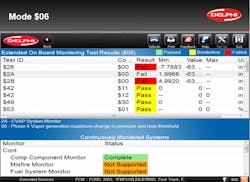Scan tools are essential tools ... but not the only tools
Vehicles affected: all
Tools used:
- Scan tool
- Vehicle information
- Diagnostic smoke tester
- RRR machine
- Yellow Jacket ManTooth air conditioning diagnostic tool
- Digital Multimeter (DMM)
- Fuel pressure tester
Throughout the history of diagnostic repair, there’s always been one universal truth: If you don’t have access to a good scan tool, you’re very unlikely to accurately diagnose a number of vehicles that come into your shop. In fact, the majority of your customers may think all you need to do is hook up your “thingy” to their car and it’ll tell you what’s wrong.
Though not impossible, using only your scan tool will rarely provide you with a diagnosis. However, it’s just a starting point to begin your testing process. In this month’s Tool Briefing, we’ll be discussing some common fault codes, other computer-controlled system failures, and tools you’ll need to perform tests that are necessary to accurately diagnose an issue after you have obtained the proper codes with your scan tool.
Issue one: P0442 fault code – Small leak detected in evaporative system
The easiest check to perform first with any evaporative system (evap) leak is to make sure the fuel cap is present and tightened properly. Even if the cap is tight, it may be the cause of the leak, but in this case, someone has already tightened the cap.
After that easy check, you should look at the freeze frame data with your scan tool. This data contains a listing of what was occurring at the time the code was set. Depending on the vehicle, some of the data available may include how long the engine was running, the engine and vehicle speed, engine temperature, and possibly the fuel level. All of this information may assist you in determining what caused the fault. Having it available to you will also enable you to operate the vehicle under the same conditions after the repair to make sure the code doesn’t reset.
After you have the freeze frame data, refer to your vehicle information source to determine what the enabling criteria (the operating conditions) are to trigger the fault code. This is critical if you’ll be performing a drive cycle to verify your repair.
Most vehicles use similar criteria for monitoring the evap system and will need 15 to 85 percent fuel level. If the fuel level is either above 85 percent or below 15 percent, the test won’t run, and you’ll likely spend hours and multiple drive cycles attempting to validate your repairs without success. These vehicles also monitor engine and ambient air temperature. Upon startup, the two temperatures need to be within 10 degrees of each other. If not, the computer assumes it’s not a cold start and will not perform an evap test.
Another common condition that’s difficult to overcome is the ambient air temperature. Many vehicles will not run an evap test if the air temperature is above 104 degrees F or below 32 degrees F. That’s because tank pressure can change drastically either above or below those temperatures, making leak detection difficult.
The evap monitor test needs multiple tests to either pass or fail, so your scan tool can be used to look at Mode $06 information to see which part of the evap system malfunctioned. This is done by observing the Mode $06 data to see specifically which part of the evap test failed, which allows you to get information from your vehicle information system about that aspect of the evap test process. You can then use that as a starting point for your testing.
Your scan tool also has the ability to control some features of the evap monitor test as well as monitor the datastream to see if it’s functioning. Many scan tools will allow you to perform what is commonly known as a “Service Bay Test”, basically an electrical test of the purge and vent functions of the system. Using bidirectional controls and monitoring various PID’s, you will also be able to see if the purge valve is opening and closing properly by monitoring oxygen sensor voltage, or, with some vehicles, fuel tank pressure.
One of the best tools to locate evap system leaks is a diagnostic smoke machine. Connecting a smoke machine allows you to easily observe any trace of smoke that would indicate a leak, but in some cases, you will need to use the smoke machine and a little ingenuity to find a leak. I have had multiple vehicles that had a faulty purge solenoid which did not completely close, thereby allowing the system to lose pressure (vacuum).
Even though the system was still closed to the atmosphere, the computer system detected a leak. The way I tested for a faulty solenoid was to connect the smoke machine to the system, then disconnect the hose from the purge solenoid to determine if there was a leak. A helpful hint for finding traces of smoke, especially in a brightly lit shop, is to wave a laser pointer around the area of a suspected leak. The laser light will highlight any faint traces of smoke.
Issue two: HVAC system issues
With most modern vehicles using the body control computer and the power-train control module (PCM) to control HVAC functions, a scan tool along with your Recover/Recycle/Recharge (RRR) machine is now necessary to fully diagnose any issues within the system.
First, check for any fault codes in either the PCM, body control module (BCM), or HVAC systems. If no codes are present, connect your RRR machine to the vehicle, and, if necessary, recharge the system. Once you know the system is properly charged, your scan tool can provide you with valuable information regarding zone temperatures, door positions, and various other pieces of information that can provide you clues to a diagnosis.
One tool that’s been extremely helpful in quickly diagnosing “problem vehicle” A/C systems is the Yellow Jacket ManTooth Wireless Pressure/Temperature Gauge Automotive Kit. It consists of a series of Bluetooth connected pressure and temperature probes that allow an app on your mobile device to not only monitor, but diagnose issues based on temperature and pressure while you are driving the vehicle. Not only is this a great tool for every vehicle for final test drive verification, but is extremely valuable for intermittent issues allowing you to safely monitor system pressures and temperatures while driving.
Issue three: P0420 fault code – Catalytic converter issues
It may seem simple enough that if you get a code for a faulty catalytic converter, you should be able to replace the converter and be good to go, right? Not so in most cases. You need to look at your vehicle information database to determine what conditions need to occur in order to set that fault code. Along with the conditions, determine which sensors the computer is using to monitor the system. Most vehicles will use O2 sensor data, both upstream and downstream, to monitor the exhaust to see if the catalytic converter is doing its job.
Factors that prevent the system from working properly include unmonitored air in the exhaust stream (exhaust leaks), faulty oxygen sensors, engine oil or coolant leaking into the intake, exhaust fouling an O2 sensor or the converter, or misfires.
Whether you’re diagnosing the cause of the fault code or the cause of a converter failure, your scan tool will be necessary, but you’ll also need additional tools. Your scan tool will be required to monitor the datastream of the O2 sensors, engine temperature, fuel trim, and other factors the PCM uses to maintain control of the fuel the engine is using. One thing to keep in mind, the primary goal of an OBD-II system is to monitor and control the engine fuel system to reduce emissions and maintain catalytic converter functionality, and then alert if there are any catalyst damaging events occurring.
Because exhaust leaks may allow air to enter the exhaust stream between the upstream and downstream O2 sensors, it’s a fairly common reason a faulty converter code will set, even if the converter is functioning correctly. The best tool I have found to check for exhaust leaks is a high- pressure diagnostic smoke tester. The higher pressure this tool creates, rather than a traditional smoke machine, will allow you to detect even the smallest leaks in an exhaust system.
Another easily overlooked cause of catalytic converter failures is a system that runs overall lean or rich. To check this part of the system, you’ll need a fuel pressure gauge, preferably one that allows you to check volume as well as pressure, along with your scan tool which will enable you to command a PCM controlled fuel pump at full speed.
Other tools I’ve found to be useful when checking the fuel pump are a digital multimeter (DMM) or a Fuse Buddy. Both tools allow you to easily measure the current that the fuel pump is drawing to deliver fuel. A general rule of thumb is that a properly functioning fuel pump will draw 1A for every 10 psi of fuel pressure. For example, a 70 psi system should draw approximately 7A. Higher current draw can indicate a faulty pump, or a restriction in the system (filter). A lower than normal draw may be an indicator of a fuel pump that is cavitating, or high resistance in the electrical supply to the fuel pump.
These are just a few examples of additional tools that are required to fully test a system after using your scan tool to do a preliminary check. In an upcoming article, we’ll discuss the benefits of including a lab scope in your diagnostic toolbox.
About the Author

Barry Hoyland
Barry Hoyland has been in the independent aftermarket for more than 45 years as a technician, technician instructor, shop owner, and shop management consultant. He owned and operated a successful Southern California automotive repair center that offers complete auto care and specialized in emission and diagnostic services for over 28 years. Hoyland also owned a company that modified vehicles to perform as emergency response units and mobile command centers, incorporating high-end electronic components into today’s vehicles. Hoyland has experience with all size and types of vehicles including traditional gas, hybrid electric, alternative fuel, and heavy duty diesel trucks.
Hoyland has provided consulting services for many automotive shops, fleets, and government agencies in order to improve their operational efficiencies.
In addition, he has worked with many NHRA drag racing teams as a crew chief on supercharged alcohol and nitro-methane fueled cars and currently serves as a crew chief on a Top Alcohol Funny Car, a Nostalgia Funny Car, and a Nostalgia Alcohol Dragster
Hoyland holds certifications in ASE: A1, A6, A8, and L1, MACS 609, maintains a California Advanced Emission license, and a CDL with endorsements for double and triple trailers, tankers, and HazMat.
When he is not helping to run a shop in the Pacific Northwest, Hoyland travels across the U.S. as an instructor of technical and shop management courses, many of which he has developed.
